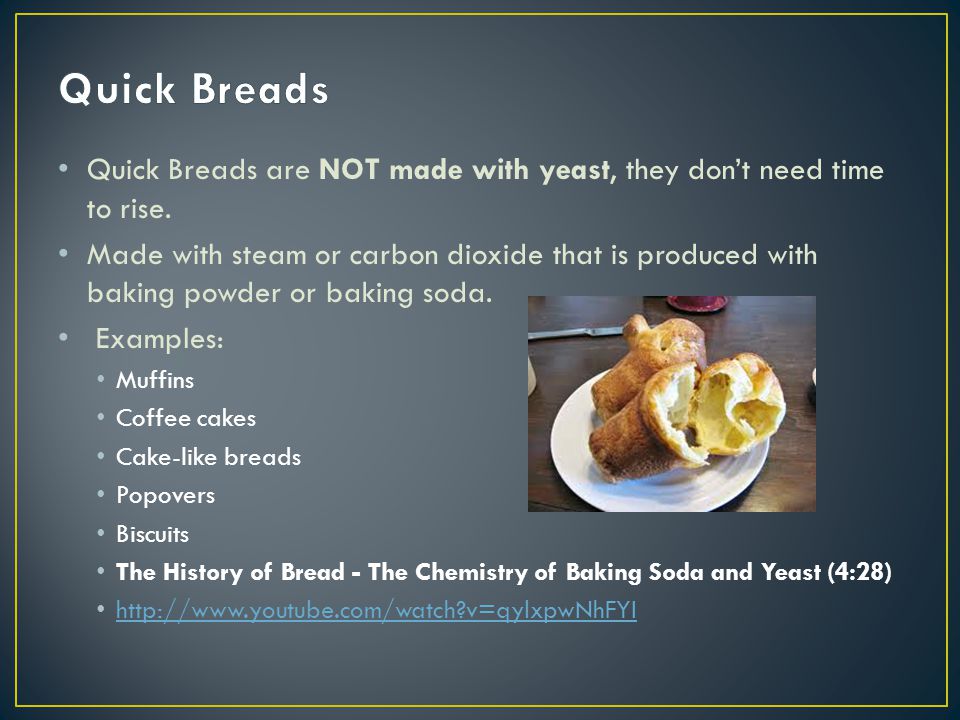
These quick breads originated in America where pearlash made from wood ash was discovered. Before that breads and cakes were leavened with yeast.

An advantage of quick breads is their ability to be prepared quickly and reliably without requiring the time-consuming skilled labor and the climate control needed for traditional yeast breads.
History of quick breads. History Quick bread possibly originated from the United States of America at the end of the eighteenth century. Before the creation of quick bread baked goods were leavened with either yeast or by mixing dough with eggs. During the American Civil War the demand for food was high.
Thus bread was rapidly made and leavened with baking soda. History Quick bread possibly originated from the United States of America at the end of the eighteenth century. Before the creation of quick bread baked goods were leavened with either yeast or by mixing dough with eggs.
During the American Civil War the demand for food was high. Thus bread was rapidly made and leavened with baking soda. Quick breads have evolved as a distinctly different tradition after the introduction of baking powder in 1850.
Before that breads and cakes were leavened with yeast. It has in fact replaced yeast as a leavening agent for cakes almost entirely but not yeast bread doughs. History of quick Breads Watch this video Dont forget to likeFollow.
History Quick bread possibly originated from the United States of America at the end of the eighteenth century. Before the creation of quick bread baked goods were leavened with either yeast or by mixing dough with eggs. During the American Civil War the demand for food was high.
Thus bread was rapidly made and leavened with baking soda. What Is a Quick Bread. History of quick breads.
For thousands of years bakers relied upon the use of eggs or yeast in one form or another to. While the promise of speed and efficiency can be alluring there are both advantages and. Quick breads offer instant gratification to busy people who love to bake.
Quick breads unlike yeast breads rise with the help of quick-acting leavening agents baking powder baking soda or a combination of both and are generally baked as soon as the dough has been mixed. Now that you know quick breads are any baked good made with the use of chemical leavening agents The origin of the name quick bread was even thought to date back to when baking powder was invented in the late 1800s you can see how many different things that would be. Here are a few examples.
Quick breads chemically leavened were not developed until the end of the 18th century. Up until that time to make light baked goods you had to beat air into the dough with eggs or egg whites or by using yeast or beer. These quick breads originated in America where pearlash made from wood ash was discovered.
It produces carbon dioxide gas in dough. Bread was central to the formation of early human societies. From the Fertile Crescent where wheat was domesticated cultivation spread north and west to Europe and North Africa and east towards East Asia.
This in turn led to the formation of towns as opposed to the nomadic lifestyle and gave rise to more and more sophisticated forms of societal organization. Similar developments occurred in the Americas with maize and. The remains of a hearth provide the first evidence that bread was made fourteen thousand years ago and four millennia before agriculture began.
The results recently published in Proceedings of the National Academy of Science show that at least 24 of the 642 food fragments found are believed to be breadcrumbs. Purportedly invented in the 18th century by John Montagu 4th Earl of Sandwich. First developed in 18th-century Paris later refined and first named baguette in 1920.
Mechanized bread slicer invented in 1917 in widespread use by 1930. Food needed to be easy to prepare and portable qualities that quick breads fulfilled. Additionally there was a shortage of laborers who could create breads the traditional way making quick breads the perfect option.
The History of Bread Recent evidence indicates that humans processed and consumed wild cereal grains as far back as 23000 years ago in the Upper Paleolithic period. From the Neolithic period 9500 BC simple stone mechanisms were used for smashing and grinding various cereals to remove the inedible outer husks and to make the resulting grain into palatable and versatile food. Quick bread is any bread leavened with leavening agents other than yeast or eggs.
An advantage of quick breads is their ability to be prepared quickly and reliably without requiring the time-consuming skilled labor and the climate control needed for traditional yeast breads. Quick bread is any bread leavened with leavening agents other than yeast or eggs. An advantage of quick breads is their ability to be prepared quickly pastries List of pies tarts and flans List of puddings List of quick breads List of sandwiches List of sweet breads List of toast dishes List of Uruguayan to baking soda in quick breads In the US soda breads were first publicised by Amelia.
1 History 2 Leavening process 3 Mixing methods 4 Dough consistency 5 References Quick bread is any bread leavened with leavening agents other than yeast or eggs. An advantage of quick breads is their ability to be prepared quickly and reliably without requiring the time-consuming skilled labor and the climate control needed for traditional yeast breads. Quick breads include many cakes.